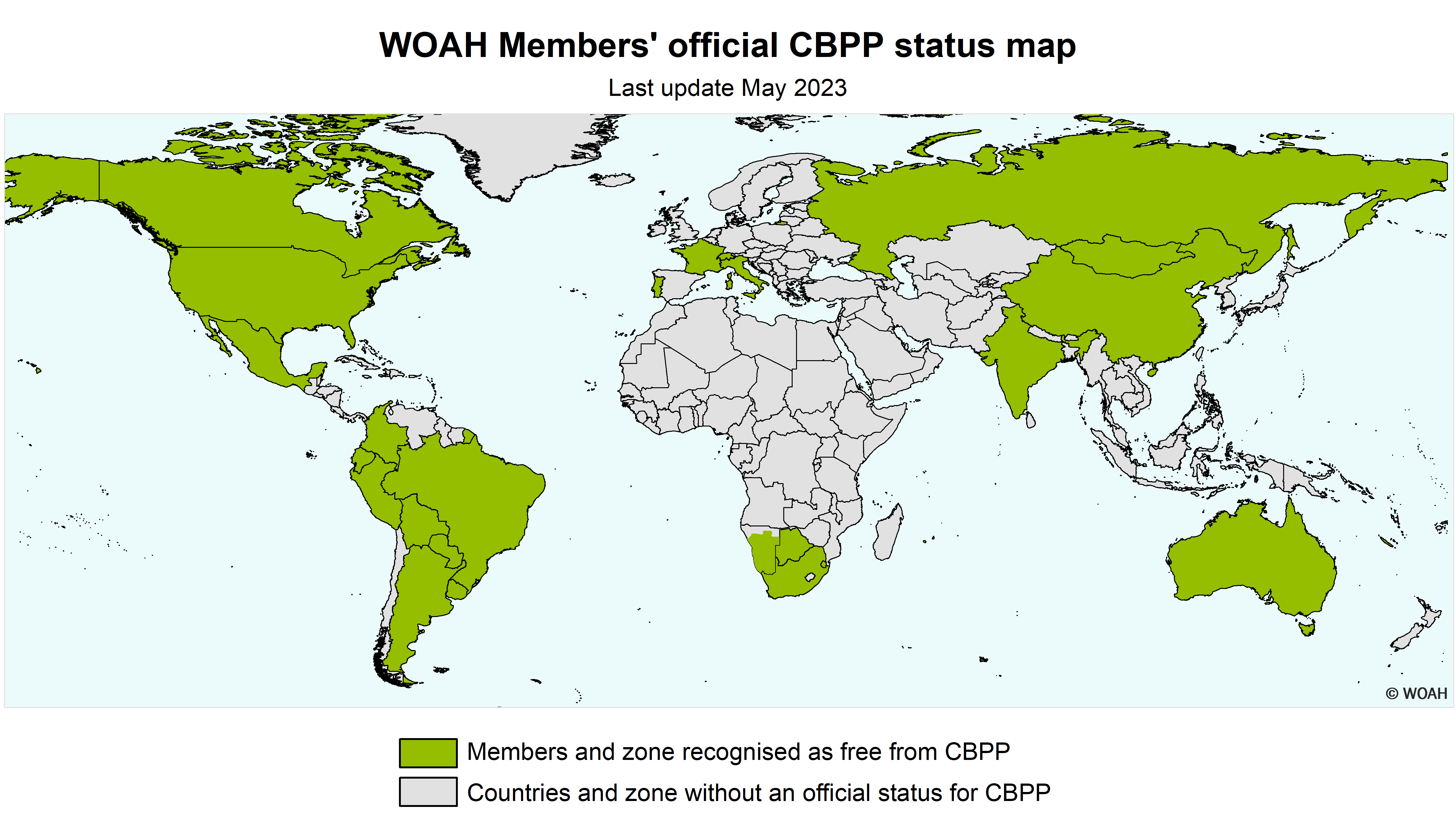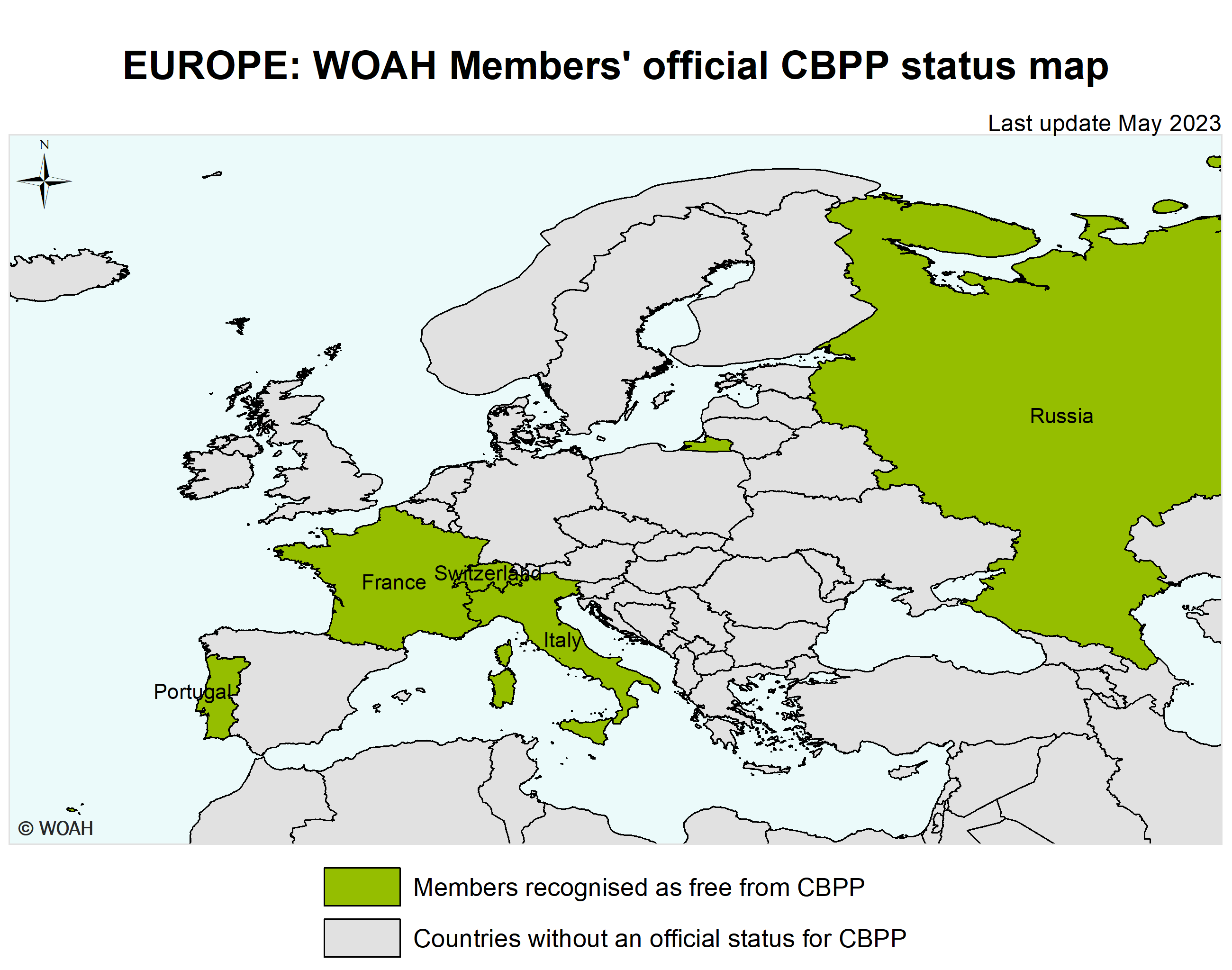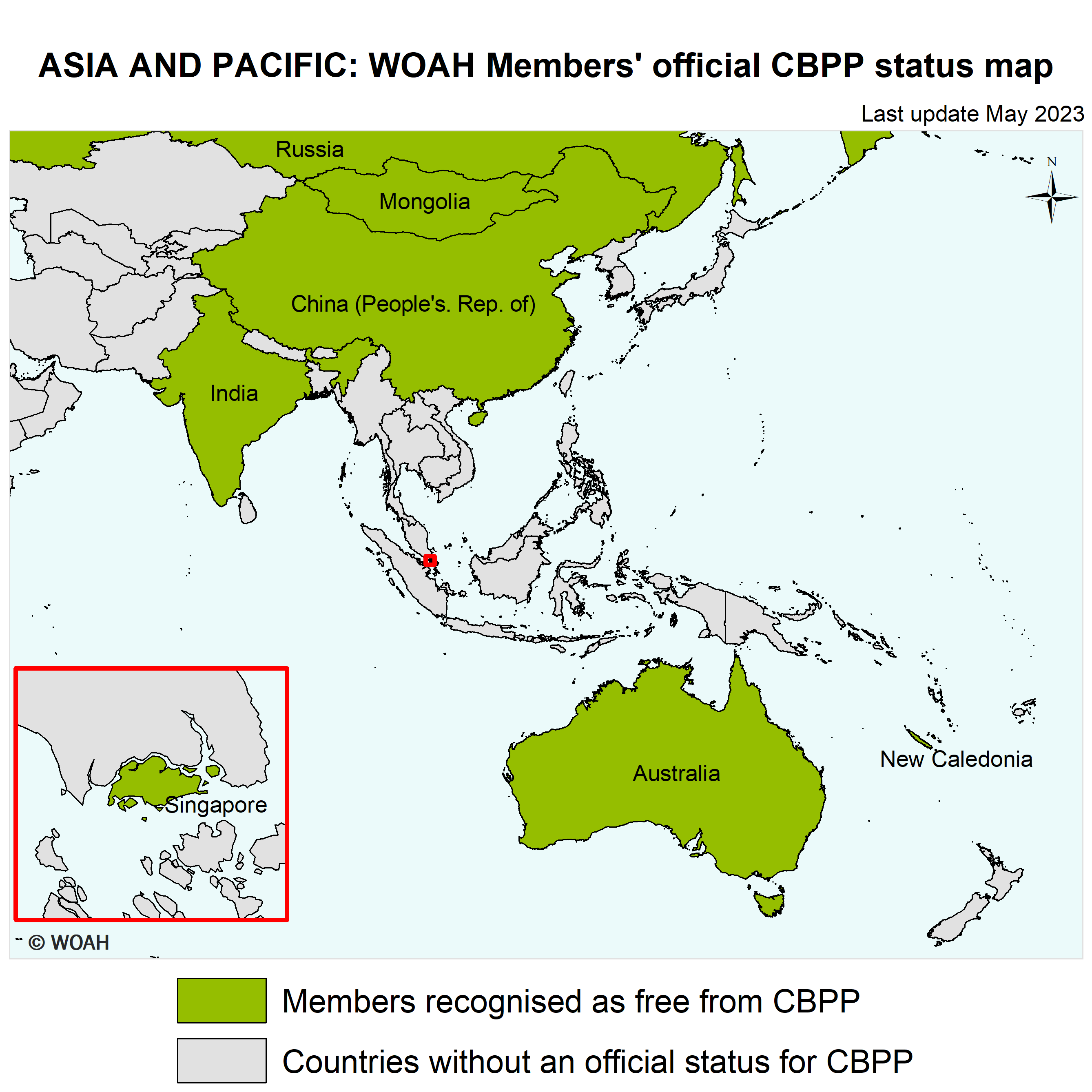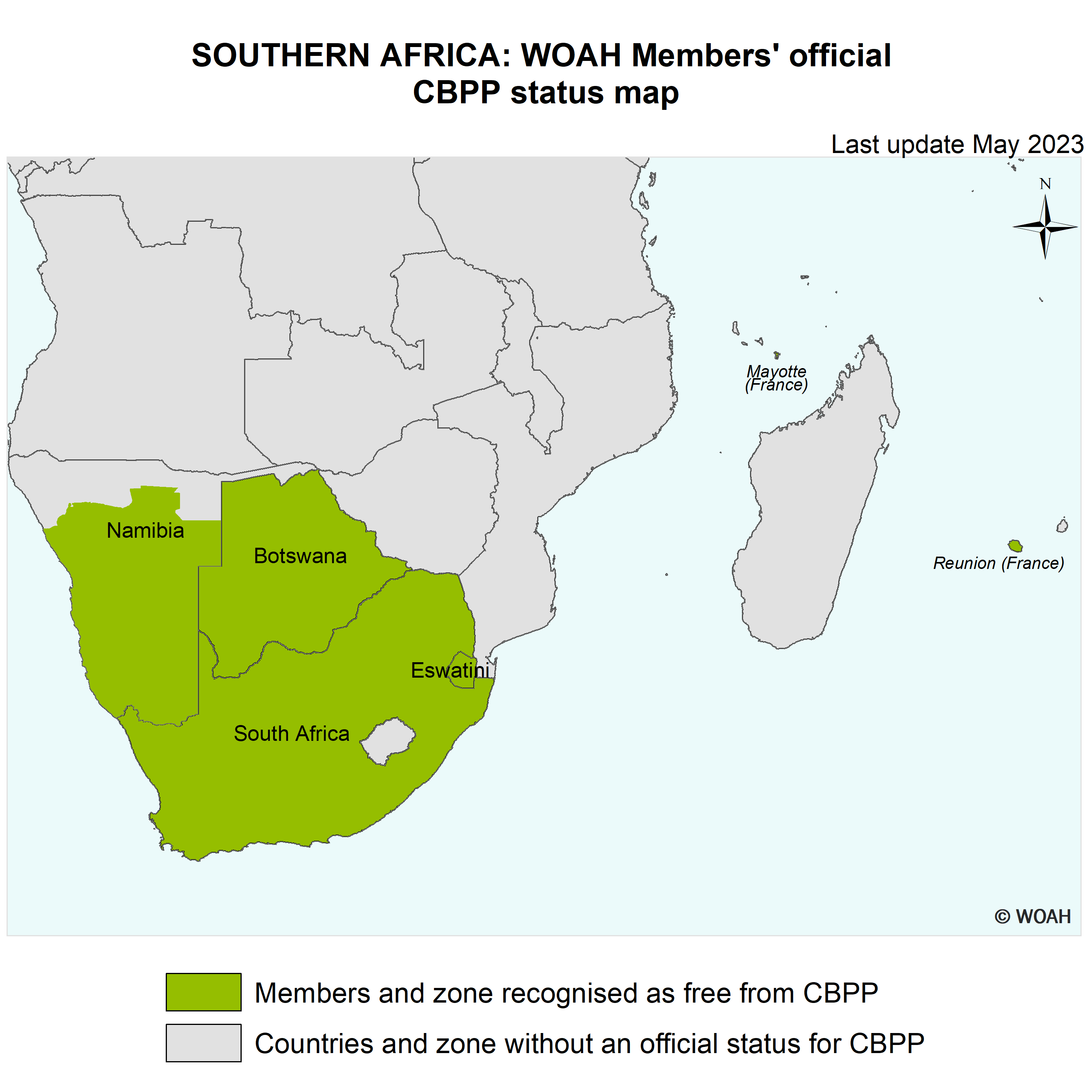Contagious bovine pleuropneumonia
Contagious bovine pleuropneumonia (CBPP) caused one the three great historic cattle plagues of the world along with foot and mouth disease and Rinderpest. CBPP was first recognized in Germany in 1693, and the history of its introduction to countries and its subsequent eradication often parallels the development of veterinary services. The USA has been free of the disease since 1892, the UK since 1898, South Africa (where the disease was introduced by the importation of infected bulls from Holland in 1853) since 1924, Australia since the 1970s, and China since the 1980s. After its elimination from Europe in the nineteenth century, the disease reappeared in Portugal and Spain in 1951 and 1957, respectively. A few outbreaks were reported in southern France, the latest in 1984. In Italy, the disease reappeared in 1990 but was eliminated by 1993, and the last case in Europe was in Portugal in 1999.
Links to Code and Manual
-
Terrestrial Code
-
Terrestrial Manual
What is Contagious bovine pleuropneumonia?
Contagious bovine pleuropneumonia (CBPP) is a disease of cattle and water buffalo caused by Mycoplasma mycoides subsp. Mycoides (M. mycoides). As the name suggests, it attacks the lungs and the membranes that line the thoracic cavity (the pleura) causing fever and respiratory signs such as laboured or rapid respiration, cough and nasal discharges.
Because it is highly contagious with a mortality rate of up to 50%, it causes significant economic losses. CBPP is a prominent cattle disease in Africa.
CBPP is a disease listed by the WOAH in the Terrestrial Animal Health Code. Members are obligated to report occurrences of the disease according to the standards in the WOAH Terrestrial Animal Health Code.
CBPP is one of the diseases for which the WOAH has established an official procedure for recognition of status. The WOAH Terrestrial Animal Health Code specifies the steps a country must follow in order to be officially recognized by the WOAH as free of CBPP.
Transmission and spread
Transmission of the disease occurs through direct contact between an infected and a susceptible animal which becomes infected by inhaling droplets disseminated by coughing. Since some animals can carry the disease without showing signs of illness, controlling the spread is more difficult.
There is no evidence of transmission through fomites (inanimate objects such as clothing, implements or vehicles) as the organism does not persist in the environment.
Public health risk
Humans are not known to be susceptible to CBPP, so there is no public health risk.
Clinical signs
CBPP is manifested by loss of appetite, fever and respiratory signs, such as rapid respiratory rate, cough and nasal discharges and painful, difficult breathing. In hot climates, an affected animal often stands by itself in the shade, its head lowered and extended, its back slightly arched, and its limbs turned out. In many cases, the disease progresses rapidly, animals lose condition, and breathing becomes very laboured, with a grunt at expiration. The animals become recumbent (lie down) and in severe cases die after 1-3 weeks.
The mortality rate may be as high as 50% in the absence of antibiotic treatment. However, clinical signs are not always evident. Subacute or asymptomatic forms can occur as affected animals partially recover after a period of three to four weeks. However, these cattle may be capable of spreading the disease, acting as unapparent carriers.
Diagnostic
The diagnosis is based on isolation of M. mycoides from samples such as nasal swabs and/or lung washings or pleural fluid obtained by puncture, or necropsy samples. The Manual of Diagnostic Tests and Vaccines for Terrestrial Animals describes in details the diagnostic procedures for CBPP.
Prevention and control
The main problems for control or eradication are the frequent occurrence of subacute or unapparent infections and the persistence of chronic carriers after the clinical phase.
In most continents, control strategies are based on the early detection of outbreaks, control of animal movements and a stamping-out policy. This has successfully eliminated the disease from North America and Europe. In Africa control of the disease is currently based mainly on vaccination campaigns.
Surveillance of the disease through slaughterhouse inspection is an efficient method of detecting clinical cases.
Treatment of affected animals with antibiotics can result in healthy looking animals that are still infected and able to spread the disease, so it is not recommended.
Vaccination with an attenuated strain of the bacteria is used to reduce the level of infection. Vaccine is produced following the guideline in the WOAH Manual of Diagnostic Tests and Vaccines for Terrestrial Animals.
Geographical distribution
CBPP was known in Europe as early as the 16th century. It was spread throughout the world by increased international trade in live cattle in the second half of the 19th century. Stamping out policy eradicated the disease from many countries; however it currently persists in sub-Saharan Africa.
References
In accordance with the WOAH procedure for official recognition of disease status, this page provides access to the List of WOAH Members officially recognised free from contagious bovine pleuropneumonia (CBPP) by the WOAH through the adoption of a resolution by the World Assembly of Delegates (Assembly) of the WOAH at the General Session in May every year.
A Member wishing to be officially recognised as disease-free by the WOAH should submit the questionnaire laid out in Chapter 1.6. of the WOAH Terrestrial Animal Health Code (Terrestrial Code) and comply with all requirements specified in the Terrestrial Code for CBPP. The WOAH Scientific Commission for Animal Diseases (Scientific Commission) is responsible for undertaking, on behalf of the Assembly, the assessment of WOAH Members’ applications for their compliance with WOAH standards. The assessment carried out by the Scientific Commission is based on the recommendations formulated by a relevant ad hoc Group composed of world specialists in disease control.
-
Questionnaire
A_Questionnaire_CBPP
.docx – 81 KB See the document -
Questionnaire
A_Questionnaire_CBPP__programme
.docx – 71 KB See the document
Subsequent to a disease outbreak or when the Scientific Commission determines that the conditions are not met anymore to demonstrate compliance with the relevant requirements of the Terrestrial Code, a disease status may be suspended. The Scientific Commission may decide to reinstate the suspended status when a Member has submitted an application which fulfils all the requirements requested for the recovery of official disease status laid out in the relevant Chapters of the Terrestrial Code. The suspensions and recoveries of disease status are announced by the Director General of the WOAH in consultation with the Scientific Commission and the list of these is kept up to date until adoption of a new resolution by the Assembly the following May.
Members with a disease free status officially recognised by the WOAH must submit an annual reconfirmation form by the end of November every year.
-
.docx – 45 KB See the document
-
.docx – 50 KB See the document
Map of CBPP official status
List of CBPP free Members
According to Resolution No. 13 (90th General Session, May 2023)
CBPP free Members
Members recognised as free from CBPP according to the provisions of the Chapter 11.5. of the Terrestrial Code :
| Argentina | Eswatini | Peru |
| Australia | France (1) | Portugal (2) |
| Bolivia | India | Russia |
| Botswana | Italy | Singapore |
| Brazil | Mexico | South Africa |
| Canada | Mongolia | Switzerland |
| China (People’s Republic of) | New Caledonia | United States of America |
| Colombia | Paraguay | Uruguay |
| Ecuador |
(2) Including Azores and Madeira.
CBPP free zone(3)
Members having a CBPP free zone according to the provisions of Chapter 11.5. of the Terrestrial Code:
| Namibia: Map | one zone located south of the Veterinary Cordon Fence, designated by the Delegate of Namibia in a document addressed to the Director General in October 2015. |
List of Members with an endorsed official control programme for CBPP
According to Resolution No. 14 (90th General Session, May 2023)
Members with an endorsed official control programme for CBPP, according to the provisions of Chapter 11.5. of the Terrestrial Code:
| Namibia | Zambia |




